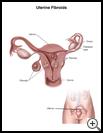
Uterine Fibroid Discharge Information
What is a uterine fibroid?
A uterine fibroid (also called a fibromyoma, leiomyoma, or myoma) is a noncancerous growth of the uterus. It grows slowly in or from the wall of the uterus and it may grow in the cervix. The uterus is the muscular organ at the top of the vagina. Babies grow in the uterus, and menstrual blood comes from the uterus. The cervix is the lower part of the uterus that opens into the vagina.
A uterine fibroid may be as small as a pea or as large as a grapefruit. As the fibroid grows, it may change the shape of the uterus or move it out of place. If this happens, it may cause symptoms in your bladder or intestines. In rare cases, a rapidly growing fibroid may become cancerous.
The cause of uterine fibroids is not known. Estrogen and other hormones produced by the ovaries may play a role. Fibroids are common in women between the ages of 20 and 50. When a woman goes through menopause, the fibroids usually shrink. Your risk for fibroids may be greater if other women in your family have had them.
How can I take care of myself when I go home?
How long it takes to get better depends on your treatment, how well you recover, your overall health, and any complications you may have.
Management
- Your provider will give you a list of your medicines when you leave the hospital.
- Know your medicines. Know what they look like, how much you should take each time, how often you are to take them, and why you take each one.
- Take your medicines exactly as your provider tells you to.
- Carry a list of your medicines in your wallet or purse. Include any nonprescription medicines and supplements on the list.
- Talk to your provider before you use any other medicines, including nonprescription medicines.
- Your provider may prescribe medicine to:
- Treat pain
- Treat or prevent an infection
- Treat or prevent side effects, such as nausea or constipation, from other treatments
- Soften your bowel movement to reduce straining
- Your provider may recommend other types of therapy to help relieve pain, other symptoms, or side effects of treatment.
- If you have had surgery, to care for your surgical wound:
- Keep your surgical wound clean.
- If you are told to change the dressing on your surgical wound, wash your hands before changing the dressing and after disposing of the dressing.
- Follow any activity restrictions recommended by your healthcare provider, such as no heavy lifting or putting strain on your belly muscles, or not driving or operating machinery (especially if you are taking pain medicines.)
- Do not put anything in the vagina, including tampons, or have sex until your provider says it is okay.
- If you have had a hysterectomy:
- If you were having menstrual periods before the surgery, you will no longer have them after the operation.
- You cannot become pregnant.
- If your ovaries were removed, menopause starts right away. Your provider may discuss hormone replacement therapy with you.
- Take care of your health. Try to get at least 7 to 9 hours of sleep each night. Eat a healthy diet and try to keep a healthy weight. If you smoke, try to quit. If you want to drink alcohol, ask your healthcare provider how much is safe for you to drink. Learn ways to manage stress. Exercise according to your healthcare provider's instructions.
Appointments
- Follow your provider's instructions for follow-up appointments.
- Keep appointments for any testing you may need.
Talk with your provider about any questions or concerns you have.
Call your healthcare provider if you have new or worsening:
- Dizziness or lightheadedness
- Shortness of breath
- Belly pain
- Change in bowel habits, such as pain, mucus, diarrhea, constipation
- Trouble emptying your bladder
- Heavy vaginal bleeding
- Vaginal discharge with a bad odor or itching
- Signs of infection around your surgical wound. These include:
- The area around the wound is more red or painful
- The wound area is very warm to touch
- You have blood, pus, or other fluid coming from the wound area
- You have a fever higher than 101.5° F (38.6° C)
- You have chills or muscle aches
Last modified: 2015-04-15
Last reviewed: 2016-01-26

